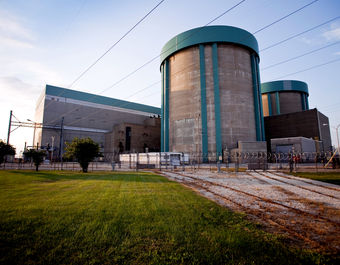
The Real Cost of Decommissioning a Nuclear Plant
At this year's festival we screened Into Eternity which takes an in-depth look at the first-ever permanent burial ground for spent nuclear waste, now being built in Finland, and the effects of that waste.
An article posted Monday on Solve Climate News tackles the same issue, highlighting the lack of options available for dealing with radioactive nuclear waste.
When the Zion Nuclear Power Station in Illinois closed its doors in 1998, plant owner Commonwealth Edison, now part of Exelon, thought it would take more than two decades to clean up the site.
At the time, Zion needed repairs that exceeded the value of the 2,080-megawatt plant, and dismantling it was the better financial option, said Craig Nesbit, vice president of communications at Exelon. But when operations ceased, the flow of money from utility ratepayers also stopped, drying up the source of Zion's decommissioning funds.
The company opted to delay its cleanup plan. Aside from removing the main reactor components, Exelon would not begin the rest of the work until the 2020s, by which time the funds would have accumulated enough interest to cover the full decommissioning process.
Luckily for Exelon, though, another option presented itself when EnergySolutions, a nuclear waste managment company based in Salt Lake City, offered to take over the decommissioning plan. The company acquired the Zion plant in September 2010. According to EnergySolutions CEO Val Christensen, full decommissioning will cost about $1 billion dollars over the next 10 years.
EnergySolutions can expedite the cleanup because of its technical capacity, said Christensen. His company is currently decommissioning 18 reactors in England. They also own a low-level nuclear waste storage facility in Clive, Utah, which will speed up the waste disposal process.
The move has saved Exelon considerable headache and illuminates some of the unseen challenges of nuclear energy operation. Indeed, other plant operators haven't been as lucky when it came to decontaminating their nuclear reactor sites. Although the usual critiques of nuclear generation revolve around safety risks and high construction fees, relatively little attention has been paid to what happens when a nuclear plant powers down for good.
Costs Can Reach Over $1 Billion
Every nuclear plant must be decommissioned at the end of its useful life, usually after it has been operating for 40-60 years. The costly, labor-intensive process involves two major actions: nuclear waste disposal and decontamination to reduce residual radioactivity.
The U.S. currently operates 104 commercial nuclear power plants. Most were built in the 1970s and are slated for decommissioning during the next three decades. As of April 2011, there were 23 nuclear units in various stages of decommissioning. Ten out of the 23 have been completely cleaned up.
According to Paul Genoa, director of policy development of the Nuclear Energy Institute, a trade group for the nuclear power industry, decommissioning costs typically run at $500 million per unit. But actual costs vary based on the plant's size and design, and some have reached over $1 billion — between 10 percent and 25 percent of the cost of constructing a nuclear reactor today.
Projects can run over budget if the plant is more contaminated than previously thought, said David Lochbaum, director of the Nuclear Safety Project at the Union of Concerned Scientists.


